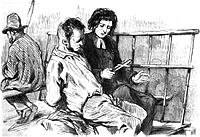The Last Day of a Condemned Man
by Victor Hugo
A man who has been condemned to death by the guillotine in 19th-century France writes down his cogitations, feelings and fears while awaiting his execution. His writing traces his change in psyche vis-a-vis the world outside the prison cell throughout his imprisonment, and describes his life in prison, everything from what his cell looks like to the personality of the prison priest. He does not betray his name or what he has done to the reader, though he vaguely hints that he has killed someone; just a nameless, faceless, meaningless victim.
Interestingly, the novel also contains a blueprint of Jean Valjean, the hero of Hugo's Les Miserables. As the Condemned is waiting to be executed he meets another condemned man who recounts his life story. The man tells him that he has was originally sent to prison for stealing a loaf of bread to save his sister's family.
At another point he tries to escape by conning a superstitious guard to give him his clothes. The guard almost does until common sense gets the better of him and he declines exchanging clothes with the Condemned.
On the day that the Condemned is to be executed he sees his three-year-old daughter for the last time, but she no longer recognizes him, and she tells him that her father is dead.
The novel ends just after he briefly but desperately begs for pardon and curses the people of his time, the people he hears outside, screaming impatiently for the spectacle of his decapitation.
